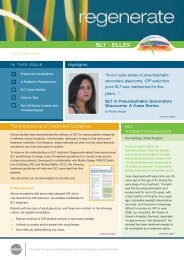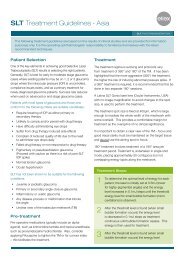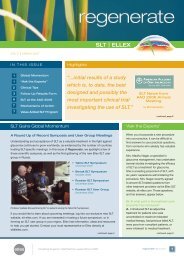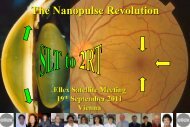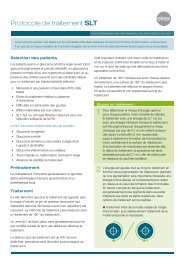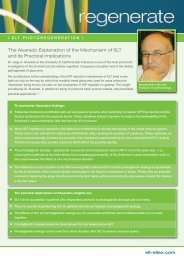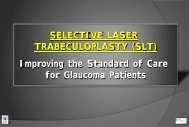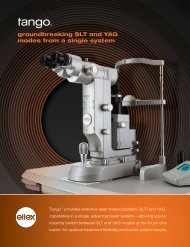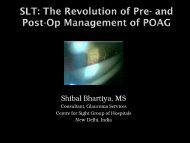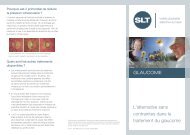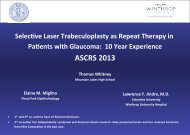Patient Brochure - SLT for Glaucoma | Ellex
Patient Brochure - SLT for Glaucoma | Ellex
Patient Brochure - SLT for Glaucoma | Ellex
Create successful ePaper yourself
Turn your PDF publications into a flip-book with our unique Google optimized e-Paper software.
<strong>SLT</strong> – the gentle alternative <strong>for</strong> glaucoma therapyWhat is <strong>SLT</strong>?Also known as Selective Laser Trabeculoplasty, <strong>SLT</strong>is a simple, yet highly effective laser procedure thatreduces the intraocular pressure associated withglaucoma. It is per<strong>for</strong>med in your ophthalmologist’soffice, and typically takes no more than five minutes.How does it work?<strong>SLT</strong> uses short pulses of low-energy light totarget the melanin, or pigment, in specific cells ofthe affected eye. In response, the body’s naturalhealing mechanisms go to work to rebuild thesecells. This rebuilding process improves drainageand lowers intraocular pressure. The surrounding,non-pigmented cells – as well as the rest of the eyestructure – are untouched and undamaged.Does <strong>SLT</strong> hurt?No. <strong>SLT</strong> is painless, and there are no side effects toworry about.GLAUCOMAWhat happens during theprocedure?Prior to treatment, eye drops are administeredto prepare the eye and provide mild anesthesia.Then, gentle pulses of light are delivered through aspecially designed microscope. The entire processtakes just a few minutes. When it’s complete, yourphysician may treat your eye with anti-inflammatoryeye drops.One to three days after the procedure, yourintraocular pressure should drop significantly. Andof course, your physician will want to re-check thetreated eye during periodic follow-up visits.How often can I have <strong>SLT</strong> done?<strong>SLT</strong> is gentle, non-thermal and non-invasive – whichallows the procedure to be repeated, if necessary.In comparison, repeat treatments of previousapproaches in laser therapy were either extremelylimited or not possible.Cause: The eye’s aqueous fluid is constantly produced and drainedat a balanced rate to ensure the health of the lens and cornea. Whenthis drainage becomes blocked, intraocular pressure increases andopen-angle glaucoma (the most common <strong>for</strong>m of glaucoma) occurs.Solution: <strong>SLT</strong> uses short pulses of low-energy light to target the melaninin specific cells of the eye. In response, the body’s natural healingmechanisms go to work to rebuild these cells. This rebuildingprocess improves drainage and lowers intraocular pressure.Who will benefit from <strong>SLT</strong>?If you fit in to any of the following categories, you’rea good candidate <strong>for</strong> <strong>SLT</strong>:• If you have primary open-angle,pseudoexfoliation, pigmentary or juvenileglaucoma. (If you’re not sure, ask yourophthalmologist.)• If you are intolerant of glaucomamedications, or have difficulty taking them asprescribed.• If you are currently undergoing glaucomadrug therapy and wish to combine it with<strong>SLT</strong>.• If it is difficult <strong>for</strong> you to commit to regularfollow-up treatments, due to finances, lackof transportation, or other limitations.• If you have a history of failed ALT (argonlaser trabeculoplasty) treatments.What if <strong>SLT</strong> doesn’t work <strong>for</strong> me?<strong>SLT</strong> lowers intraocular pressure by an average of 25percent in 75 to 85 percent of patients treated. Forthose that do not respond, other <strong>for</strong>ms of treatment,including traditional drug therapy, can still be highlyeffective.



